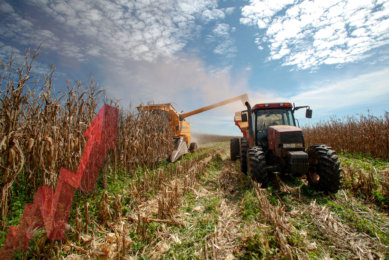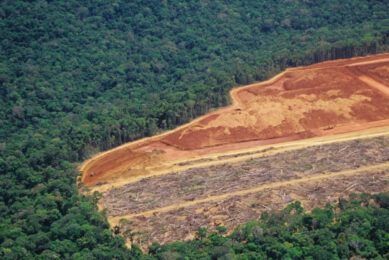AFTAA conference: Volatility of raw material prices worries industry

The French association of animal feed experts, AFTAA, has held its annual 2-day conference in Paris last December in cooperation with Finance Agri. The conference focused on risk management and how to cope with increasing volatility of raw material prices. Our correspondent in France, Philippe Caldier reports.
By Philippe Caldier
Jean-François Courtin from Cargill kicked off the conference. In the first presentation of the morning of the first day he focused on the soybean market. “Soybeans are a key raw material, its share in the world’s oilseed balance is increasing,” said Courtin. At around 420 million tonnes of world oilseed production in 2009/10, soybean with 260 million tonnes has more than a 60% share, far ahead of rapeseed (60 million tonnes) and sunflower (30 million tonnes). At world level, soybean has registered three consecutive record harvests, with a significant come back of South America. Cumulated production of Brazil, Argentina and Paraguay have reached 130 million tonnes in 2009/10, US harvest was about 92 million tonnes.
“Soybean cake demand exceeds its historical trend,” added Courtin with concrete figures: +4.1% growth on average from 2000 to 2008, +8.2% in 2009/10, and +6.2% in 2010/11. As a consequence of this high level of global soybean cake demand, US soybean stocks have become tighter over three consecutive years. This trend is the same for vegetable oils demand which has been steadily increasing with 4% to 5% per year since 2005 to reach 143 million tonnes in 2010/11 (vs 114 million tonnes in 2005/06). One of the “engines” of this global demand in soybean cake is China, explained Courtin. The share of China in world soybean cake consumption has gradually increased from 12% of the world consumption in 2001/2002 to 24% in 2010/11 (Table 1).“China accounts now for more than 60% of world soybean seed exchanges against 10% at the beginning of the 2000,” said Courtin who estimates Chinese soybean seed demand has been under-evaluated from 2007 to 2009. Strategic Chinese stocks of soybeans have been multiplied by five in three years, from 2.1 million tonnes in 2007/08 to 9.2 million tonnes in 2010/11. China is intensifying its animal production and its needs for soybean cakes will continue to grow in the future, concluded Courtin.
Wheat and maize markets
Vincent Magdelaine from Coop de France analysed the wheat and maize markets. “The new explosion in prices which occurred in 2010 on the world market has to be placed in a different context compared to 2007/08,” he said. In 2007, the price rise was linked to the historically low level of stocks all over the world and the very low US dollar. In 2010, price movements are caused by a decrease of production due to the drought that affected the Black Sea region, and if the increase of prices is less strong, it also concerns maize. “Russian wheat production dropped by 30% but it accounts for only 3% of the world production,” argued Magdelaine who added that the Black Sea region will not export any more in 2010/11.
Russian wheat production dropped from 61.7 million tonnes in 2009/10 to 42 million tonnes in 2010/11, namely a drop of 32%. The drop also affected Kazakhstan whose wheat production dropped from 16.5 million tonnes in 2009/10 to 11 million tonnes in 2010/11, a drop of 33% but accounting only for 0,9% of world production. Ukrainian wheat production also decreased but less severely, from 20.9 million tonnes in 2009/10 to 17.2 million tonnes in 2010/11. “Russia accounts for 20% of the world exchanges in wheat, which will disappear in 2010/11 and this regional drop in wheat production will impact world prices,” Magdelaine said. Regarding the US market, the production figures presented in Paris show a progression of maize against wheat. In the US, the demand for maize is everywhere: in the bio-ethanol market (demand increased from 116 million tonnes in 2009 to 119 million tonnes in 2010), for export (from 50 to 51 million tonnes), and for the feed industry (from 131 to 137 million tonnes). As a consequence, US maize stocks have been divided by two in 2010 (they reached 40-45 million tonnes in 2009). At world level, Magdelaine identified two movements in wheat production: areas where production is increasing (as in China or India and Pakistan) while other areas are decreasing their production such as EU and North America. In Europe, grain production decreased on average by 5% in 2010, with big variations among grain types: -1% for wheat, -15% for barley, -3% for maize.
Raw materials support investments
“Raw materials have acquired support from investors just like other commodities,” said Frédéric Lorenzini director of research for Morningstar, a leading provider of independent investment research in North America, Europe, Australia, and Asia. “During periods of crisis, people like investments because it signifies value and raw materials answer to this demand,” Lorenzini explained.
In order to manage the volatility of raw materials, derived products (derivatives) have been introduced, giving an easier access to the market to all kinds of speculators. On the other hand, the increasing share of electronic transactions, growing from less than 10% four years ago to more than 90% today, has made the market more fragile. “We have an increasing number of operators whose number of monthly contracts steadily increases,” Lorenzini said. As an example he names the limited number of contracts per operator, which has been multiplied by four for maize between July 1999 and December 2005 at the Chicago Mercantile Exchange, or increasing from 4,500 to 13,500 contracts/month. “We are probably about to face new trouble and there are several objective factors of tension on those raw material markets,” commented Lorenzini.
The recent developments in Europe of the Exchange Trader Found (ETF) commodities will create ghostly exchange volumes and finally the market will not be led any more by the physical market but by the financial operators. “Raw material markets are now open to anyone and not only to professionals. Decision centres moved to the East, particularly to China, an uncontrollable country,” concluded Lorenzini.
Protein opportunities
In his presentation on proteins and their interest to the feed industry, Benoît Carrouée from Unip (Interprofessional union on proteins) said that protein crop surfaces have increased in France more than forecasted, particularly pea areas grew from 95,000 ha in 2008 to 244,000 ha in 2010, while bean area grew in the same time from 60,000 to 148,000 ha. Lupines areas jumped from 2,000 to 7,000 ha between 2008 and 2010. The use of peas and bean is still low in the French feed industry in comparison with the higher levels of the 90’s, but the recent statistics are encouraging: the volumes of peas used by the feed industry increased from 155,000 t in 2008/09 to 225,000 t in 2009/10, with forecasts at 635,000 t for 2010/11. Both peas and beans can be directly used by the feed industry without expensive technological treatments and at high incorporation rates (Table 2).
A simple grinding is generally enough and pelleting improves digestibility for poultry. “Peas are a suitable protein for feed pigs,” said Carrouée, while beans are well suited for meat poultry and layers, with the recent developed new variety richer in protein (+3 points) and with low tannin rates (Fevita). Also the almost absence of mycotoxins in the fields represent another opportunity for peas and beans in animal feeds.
“Pea production is mainly facing a problem of insufficient volumes due to a lack of visibility on prices for the future,” said Carrouée. Regarding field beans he said that today this market focuses too much on export, and should be more valorised by the feed industry.











